|
Here at Gunblast.com, I receive hundreds of
emails every week from readers who want information on various
gun-related subjects. We welcome questions and input from our
readers, and try to answer each one carefully. One
question that I get asked pretty often, both by email and in
person goes something like this:
"What would be the best rifle to get my
son (or daughter or grandkid) for his first deer gun?"
That is a very good question, and one that
could have many possible, and correct, answers. That is
also a question to which I have lately given much thought, as
I have a new grandson. A first deer rifle is a big deal to a
kid, and should be carefully considered. I have seen some
well-meaning but otherwise misinformed Dads start their young
sons out with full-sized rifles that are too powerful. Not too
powerful in the sense that it kills the deer too dead, but in
that it is too much gun for the novice shooter. Starting a
twelve year old out with a .300 Weatherby magnum is foolish.
The gun is just fine for a seasoned expert, but the weight,
recoil, and muzzle blast are intimidating for a new hunter,
and that level of power is unnecessary for deer hunting. The
big three hundred magnums are fine for long range deer
hunting, but shooting at game at long range should be
discouraged for all but the expert hunter. Even if it
weren’t for the recoil and blast, most big game rifles today
are just too bulky and awkward for a young shooter to handle.
Traditionally, many hunters start out with a
lever action .30-30 carbine, and with good reason. The Winchester
and Marlin carbines are very handy rifles, and the
.30-30 Winchester has been the personification of a deer
cartridge for almost 110 years. The rifles are as much a part
of the thirty-thirty’s popularity as is the cartridge. The
lever action carbines are, in a word, handy. I like the
little guns, and I have a few that are chambered for the
excellent little cartridge.
However, after much careful consideration, I
have come to the conclusion that there is a better cartridge
for the young deer hunter: the .357 Magnum. The .357 Magnum
has been with us since 1935 as a handgun cartridge, and to a
lesser extent has been used in a few long guns. In a handy
little carbine, the .357 Magnum takes on a whole new
personality, offering much more power than from a revolver,
along with low recoil and muzzle blast. There are a few good
lever action .357 carbines available, and all are pretty good,
but the Winchester 94 Ranger Compact has a few features
that make it better than most for a young shooter.
The 94 Ranger Compact is basically the same
action that John Browning invented back in 1894, with a
few minor changes. The new action now has a rebounding hammer
and a top tang safety that blocks the hammer from contacting
the firing pin when in the "on safe" position.
This is much better than the crossbolt safety that was
incorporated into the design a few years ago. The tang safety
is relatively unobtrusive, and really only bothers old timers
like myself who have been accustomed to the original design.
Still, as I stated, it is much better than the ugly crossbolt
safety previously used.
The Ranger Compact also has Winchester’s
"Angle Eject" action that allows a scope sight to be
mounted in the normal, above the action position. Being
left-handed, I really appreciated this change when it came
along. I was never able to use a scope on a 94 with the
original straight-out-the-top ejection, as they mounted aside
the action to clear the top for ejection. I also think that a
young deer hunter deserves a good scope sight on his rifle. It
is good for any shooter to learn to use open sights, but a
good scope makes hitting in low light easier, and a new hunter
should be given every chance at success. I sometimes hunt with
open-sighted rifles, but I can hit farther with more precision
using a scope, as can most hunters. The Compact comes
with an offset hammer extension to help cock the hammer with a
scope mounted. It also has a good set of open sights, just in
case. The Marlin also allows for easy scope mounting atop the
action, but it is a heavier gun that costs more than the
Ranger Compact.
There are a couple of more features of the
Ranger Compact that make it especially useful to young
hunters, or anyone of smaller stature, and that is size. The
Compact wears a sixteen-inch barrel, and has a shorter
length-of-pull than do most rifles. The pull length, that is
the measurement from the butt plate to the trigger, measures
just twelve and one-half inches on the Ranger Compact, making
it much easier to mount properly and quickly for a young
hunter. I stand an inch under six feet tall, and have
pretty long arms, but I find the shorter stock on the Compact
very easy to use, especially when wearing heavy clothing.
Weighing just five and one-quarter pounds, the gun balances
well, and comes to the shoulder naturally, like a good bird
gun. The buttstock is finished with a good synthetic rubber
pad, which helps to absorb the already minimal recoil. The
overall length of the Ranger Compact measures just over
thirty-three inches. It is indeed a handy little rifle.
While the 94 Ranger Compact is available
chambered for the .30-30 cartridge, I prefer the .357 magnum
chambering for a youth gun, for a couple of reasons. First of
all, a hunter, any hunter, needs to practice. Rifle practice
is also fun, especially for younger hunters just getting
started. They love to shoot, if the gun doesn’t punish them
too badly. Give a new shooter a hard-kicking rifle that
doesn’t fit him properly, and he is very likely to develop a
flinch, miss his targets, and would rather stay home and watch
music videos than go hunting. The .357 Magnum in a carbine, is
very light on recoil, while packing plenty of punch for
whitetail deer, even the big ones.
Another advantage that the .357 has over the
.30-30 is that of ammo availability and cost. To start off a
new shooter, the .357 can use low recoiling and inexpensive
.38 Special ammunition. This allows for quiet, relaxing
practice that lets the shooter concentrate more on the
fundamentals of shooting and less on muzzle blast and recoil.
The young hunter can also load the Compact with .38 Special
lead semi-wadcutter ammo for small game hunting with his deer
gun. I know of no better way to practice for deer hunting than
by hunting rabbits and squirrels. The light .38 Specials will
anchor a squirrel or rabbit on the spot, without destroying
any more meat than would a .22 long rifle bullet.
As far as power, the .357 Magnum using the
right ammunition is in the same class as a good .30-30 load,
while shooting a bullet of larger diameter. From a sixteen-inch
barrel, factory thirty-thirty ammunition from the big ammo
manufacturers drives a 170 grain bullet at just under 1900
feet-per-second (fps). The .357 Ranger Compact, with the same
length barrel, drives a 180 grain bullet in excess of 1800
fps, and this too is using factory ammunition available from Buffalo
Bore. I tested the Ranger Compact over the chronograph
using a variety of factory ammunition, along with two
handloads, with the following results:
| Load |
Velocity (fps) |
| Grizzly Cartridge Co. 180-grain cast
lead |
1502 |
| Buffalo Bore 180-grain cast lead |
1812 |
| Cor-Bon .38 Special 125-grain Jaketed
Hollowpoint |
1437 |
| Handload 125-grain Jacketed Hollowpoint |
2003 |
| Handload 180-grain Hornady XTP
Hollowpoint |
1831 |
The carbine extracts much more power
from the .357 than is obtainable in a revolver. The reason for
including the lightweight Cor-Bon hollowpoints I will get to
later.
My favorite hunting handload is with the
excellent Hornady 180 grain XTP bullet at over 1800 fps
from the little carbine’s 16-inch barrel. Before the emails
start flying in, no, I will not give out the exact load data
for this handload, as I have not had it pressure tested. I
will state however, that it is perfectly safe in my particular
rifle. Extraction is easy, the primers are not flattened, and
case head expansion is normal. I am using CCI 550
magnum pistol primers and Hodgdon
Lil’Gun powder in this load. The XTP bullet really
holds together well for deep penetration, but expands
beautifully. When zeroed in at 125 yards, the bullet is only
two and one-half inches below the point of aim at 150 yards,
where it is still traveling 1360 fps. Out to 150 yards, the
bullet is never more than two and one-half inches above or
below the line of sight. This is where I would draw the line
on range, especially for an inexperienced shooter, as the
bullet drops almost one foot below line of sight at 200 yards.
However, even with a flat shooting high velocity rifle
cartridge, I would not encourage a young shooter to shoot any
farther.
For accuracy testing, I mounted a four power
compact rifle scope in Millett rings. This little .357
Ranger Compact grouped five shots within two to two-and
one-half inches at 100 yards with any load tested. That is
acceptable hunting accuracy for big game. Testing the light
.38 Special ammunition at thirty yards, it would group into
one ragged hole, making for an excellent small game rifle at
that range.
All loads tested functioned perfectly in the
94 Compact. While not really a big factor in deer hunting, the
carbine holds nine .357 Magnum rounds in the full-length
tubular magazine.
That brings us to another really good use for
this little Winchester, and that is Homeland
Security. This little carbine would make an excellent
weapon for home defense, or to carry in a vehicle for the same
purpose. Having a total capacity of ten rounds of .357 Magnum
ammo readily available, along with the ability to reload
without taking the weapon out of the fight, makes this a good
choice for a defensive carbine. With practice, a shooter can
get off ten shots in under five seconds with the little
Winchester. For use inside of a home, the Cor-Bon 110
grain Plus P hollowpoints should work very well, without the
danger of over penetration, and the recoil is very light.
There is one more really attractive feature of
the Ranger Compact, and that is the price. You can purchase
one of these, along with a good scope and mounts, and a case
of ammunition for less than most bare bolt action rifles. The
.357 Magnum combines low recoil, minimal muzzle blast, and
adequate power for deer hunting, along with unmatched
versatility to double as a small game rifle, inexpensive
plinker, or a handy home defense weapon. The Ranger
Compact is a reliable, versatile, lightweight, and handy
little carbine, and I am buying this one for my grandson.
For more information, check out:
Winchester Firearms: http://www.winchesterguns.com/
Grizzly Cartridge Company: http://www.grizzlycartridge.com/
Buffalo Bore Ammunition: http://www.buffalobore.com/
Cor-Bon Ammunition: http://www.corbon.com/ Hornady
Bullets: http://www.hornady.com/
|
To locate a dealer where you can
buy this gun, go to: |
|

|
  
Got something to say about this article? Want to agree (or
disagree) with it? Click the following link to go to the GUNBlast Feedback Page.
All content © 2004 GunBlast.com.
All rights reserved. |
|
Click pictures for a larger version.
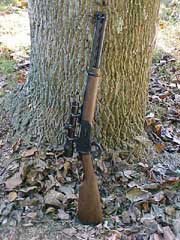
Winchester Model 94 Ranger Compact .357 Magnum.
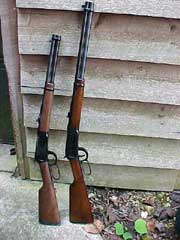
Compared to a standard 20-inch carbine (right), the
handy size of the Ranger Compact .357 is readily apparent.
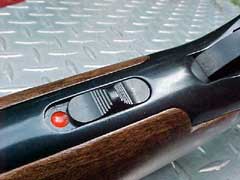
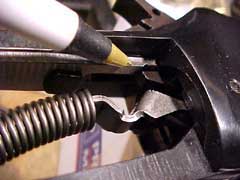
Top tang safety effectively blocks hammer movement.

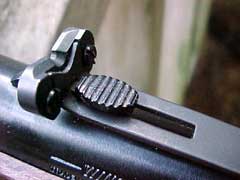
The Ranger Compact features a good set of iron sights.
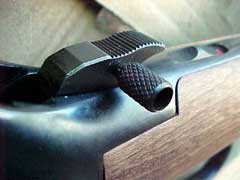
A hammer extension is included for scope use.
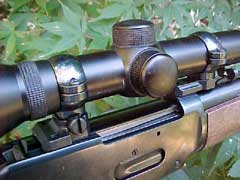
Winchester's "Angle Eject" system allows a
scope to be mounted directly over the action.
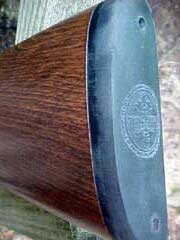
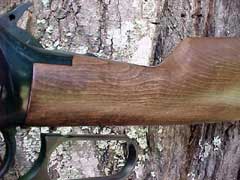
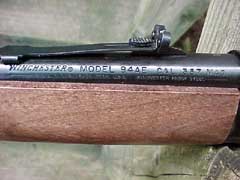
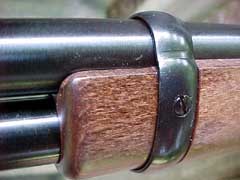

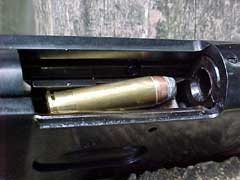
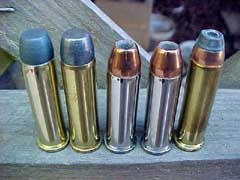
The Winchester Ranger Compact .357 performed well with a
variety of loads, including (left to right): Grizzly Cartridge
Co. 180-grain cast, Buffalo Bore 180-grain cast, Cor-Bon .38
Special 125-grain JHP, Cor-Bon .38 Special 110-grain JHP, and
author's 125-grain JHP handload.
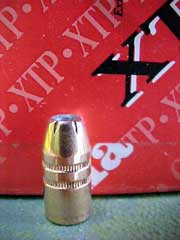
One of Jeff's favorite bullets for handloading the .357
Magnum is Hornady's 180-grain XTP JHP.
|
![]()